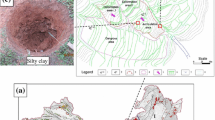Abstract
Shallow slope failure due to heavy rainfall during rainstorm and typhoon is common in mountain areas. Among the models used for analyzing the slope stability, the rainwater infiltration model integrated with slope stability model can be an effective way to evaluate the stability of slopes during rainstorm. This paper will propose an integrated Green–Ampt infiltration model and infinite slope stability model for the analysis of shallow type slope failure. To verify the suitability of the proposed model, seven landslide cases occurred in Italy and Hong Kong are adopted in this paper. The results indicate that the proposed model can be used to distinguish failed and not-yet failed slopes. In addition, the proposed model can be used as the first approximation for estimating the occurrence time of a rainfall-induced shallow landslide and its depth of sliding.













Similar content being viewed by others
References
Baum RL, Savage WZ, Godt JW (2002) TRIGRS-A fortran program for transient rainfall infiltration and grid-based regional slope-stability analysis. U.S. Geological Survey Open-File Report 02-0424, 27 p
Casagli N, Dapporto D, Ibsen ML, Tofani V, Vannocci P (2005) Analysis of triggering mechanism during the storm of 20–21 November 2000 in northern Tuscany. Landslides 3(1):13–21
Chen L, Young MH (2006) Green-Ampt infiltration model for sloping surface. Water Resour Res 42:1–9
Chen CY, Chen TC, Yu WH, Lin SC (2005) Analysis of time-varying rainfall infiltration induced landslide. Environ Geol 48:466–479
Cho E, Lee SR (2002) Evaluation of surficial stability for homogenous slopes considering rainfall characteristics. J Geotech Geoenviron Eng 128(9):756–763
Chow VT, Maidment DR, Mays LW (1988) Subsurface water. Ch. 4 in Applied hydrology. McGraw-Hill, New York
Crosta G (1998) Regionalization of rainfall threshold: an aid to landslide hazard evaluation. Env Geol 35(2–3):131–145
Duncan JM (1996) State of the art limit equilibrium and finite-element analysis of slopes. J Geotech Eng 122(7):577–596
Essig ET, Corradini C, Morbidelli R, Govindaraju RS (2009) Infiltration and deep flow over sloping surfaces: comparison of numerical and experimental results. J Hydrol 374:30–42
Evans NC, Lam JS (2002) Tung Chung East natural terrain study area ground movement and groundwater monitoring equipment and preliminary results. Geotechnical Engineering Office, Hong Kong, GEO Technical Note TN 4/2002: 105 p
Fredlund DG, Rahardjo H (1993) Soil mechanics for unsaturated soils. Wiley, New York
Gavin K, Xue J (2008) A simple method to analyze infiltration into unsaturated soil slopes. Comput Geotech 35:223–230
Hong Y, Hiura H, Shino K, Sassa K, Fukuoka H (2005) Quantitative assessment on the influence of heavy rainfall on the crystalline schist landslide by monitoring system-case study on Zentoku landslide Japan. Landslides 2:31–41
Iverson RM (2000) Landslide triggering by rain infiltration. Water Resour Res 36(7):1897–1910
Krahn J (2004a) Seepage modeling with SEEP/W. Geo Slope International Ltd., Canada
Krahn J (2004b) Stability modeling with SLOPE/W. Geo Slope International Ltd., Canada
Lan HX, Zhou CH, Lee CF, Wang SJ, Wu FQ (2003) Rainfall-induced landslide stability analysis in response to transient pore pressure: a case study of natural terrain landslide in Hong Kong. Sci China Ser E Technol Sci 46:52–68
Muntohar AS, Liao H-J (2009) Analysis of rainfall-induced infinite slope failure during typhoon using a hydrological—geotechnical model. Environ Geol 56(6):1145–1159
Philip JR (1991) Hillslope infiltration: planar slopes. Water Resour Res 27(1):109–117
Rahardjo H, Lim TT, Chang MF (1995) Shear-strength characteristics of residual soils. Can Geotech J 32:60–77
Rahardjo H, Leong EC, Rezaur RB (2002) Studies of rainfall-induced slope failures. Proceeding of the National Seminar Slope 2002, April 27, 2002, Bandung, Indonesia, pp 15–29
Richards LA (1931) Capillary conduction of liquids in porous mediums. Physics 1:318–333
Sako K, Kitamura R, Fukagawa R (2006) Study of slope failure due to rainfall: a comparison between experiment and simulation. Proceeding of the 4th International Conference on Unsaturated Soil, April 2–6, 2006, Carefree, Arizona, USA, pp 2324–2335
Simons N, Menzies B, Matthwes M (2005) Soil and rock slope engineering, Thomas Telford, London, Ch. 5
Sudhakar MR (1996) Role of apparent cohesion in the stability of Dominican allophone soil slopes. Eng Geol 43:265–279
Tofani V, Dapporto S, Vannocci P, Casagli N (2006) Infiltration, seepage and slope instability mechanisms during the 20–21 November 2000 rainstorm in Tuscany, Central Italy. Nat Hazards Earth Syst Sci 6:1025–1033
Vanapalli SK, Sillers WS, Fredlund MD (1998) The meaning and relevance of residual water content to unsaturated soils. Proceeding of the 51st Canadian geotechnical conference, 4–7 October, Edmonton, Alberta, pp 101–108
Wang XD, Benson CH (1995) Infiltration and saturated hydraulic conductivity of compacted clay. J Geotech Eng 121(10):713–722
Whitman RV (2000) Organising and evaluating uncertainty in geotechnical engineering. J Geotech Geoenviron Eng 126(7):583–593
Xie MW, Esaki T, Cai MF (2004) A time-space based approach for mapping rainfall-induced shallow landslide hazard. Env Geol 46:840–850
Zhan TLT, Ng CWW (2004) Analytical analysis of rainfall infiltration mechanism in unsaturated soils. Int J Geomech 4(4):273–284
Acknowledgments
The authors wish to thank the National Taiwan University of Science and Technology and also the Universitas Muhammadiyah Yogyakarta for jointly providing grants and scholarship to financially support this research.
Author information
Authors and Affiliations
Corresponding author
Additional information
Agus Setyo Muntohar was formerly Postdoctoral Fellow at Department of Construction Engineering, College of Engineering, National Taiwan University of Science and Technology, Taipei, Taiwan
Rights and permissions
About this article
Cite this article
Muntohar, A.S., Liao, HJ. Rainfall infiltration: infinite slope model for landslides triggering by rainstorm. Nat Hazards 54, 967–984 (2010). https://doi.org/10.1007/s11069-010-9518-5
Received:
Accepted:
Published:
Issue Date:
DOI: https://doi.org/10.1007/s11069-010-9518-5




